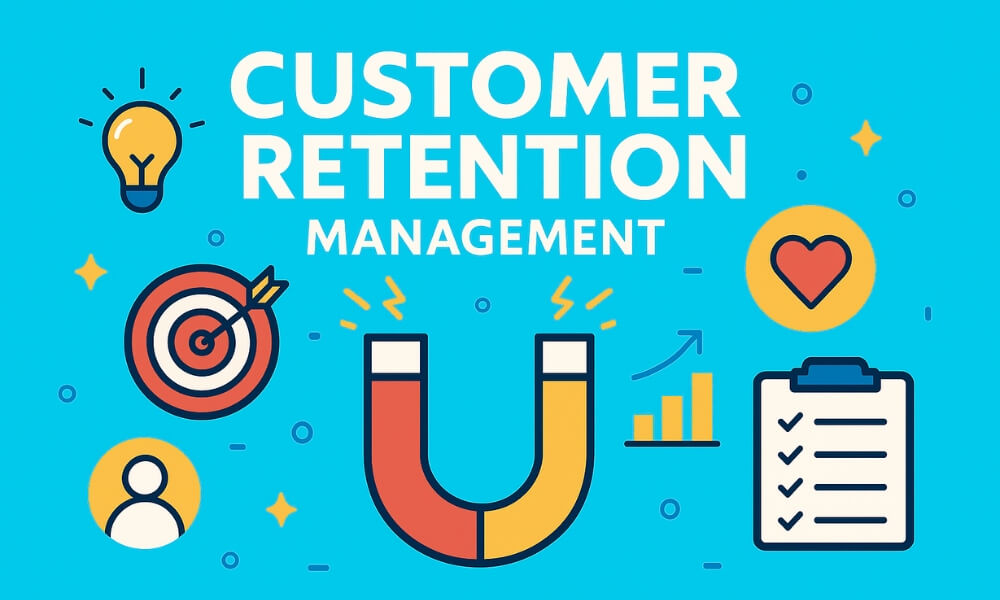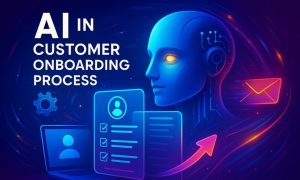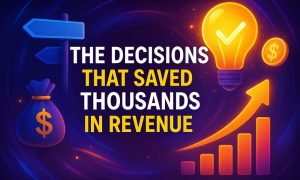Think of it like you are spending all your time filling a leaky bucket. That’s what something like when businesses focus only on acquiring new customers rather than retaining them.
But in today’s competitive market, customer retention is not just a nice-to-have. It is an important factor that drives growth. Retained customers tend to spend more and are likely to be powerful advocates for your brand.
That’s where effective customer retention management comes into play. It is a complete process where you take actions to keep customers engaged, loyal, and satisfied throughout their entire journey with your business.
In this guide, we will explain what customer retention management is, its importance, and how to build an effective retention system using proven frameworks, with the tool suggestions.
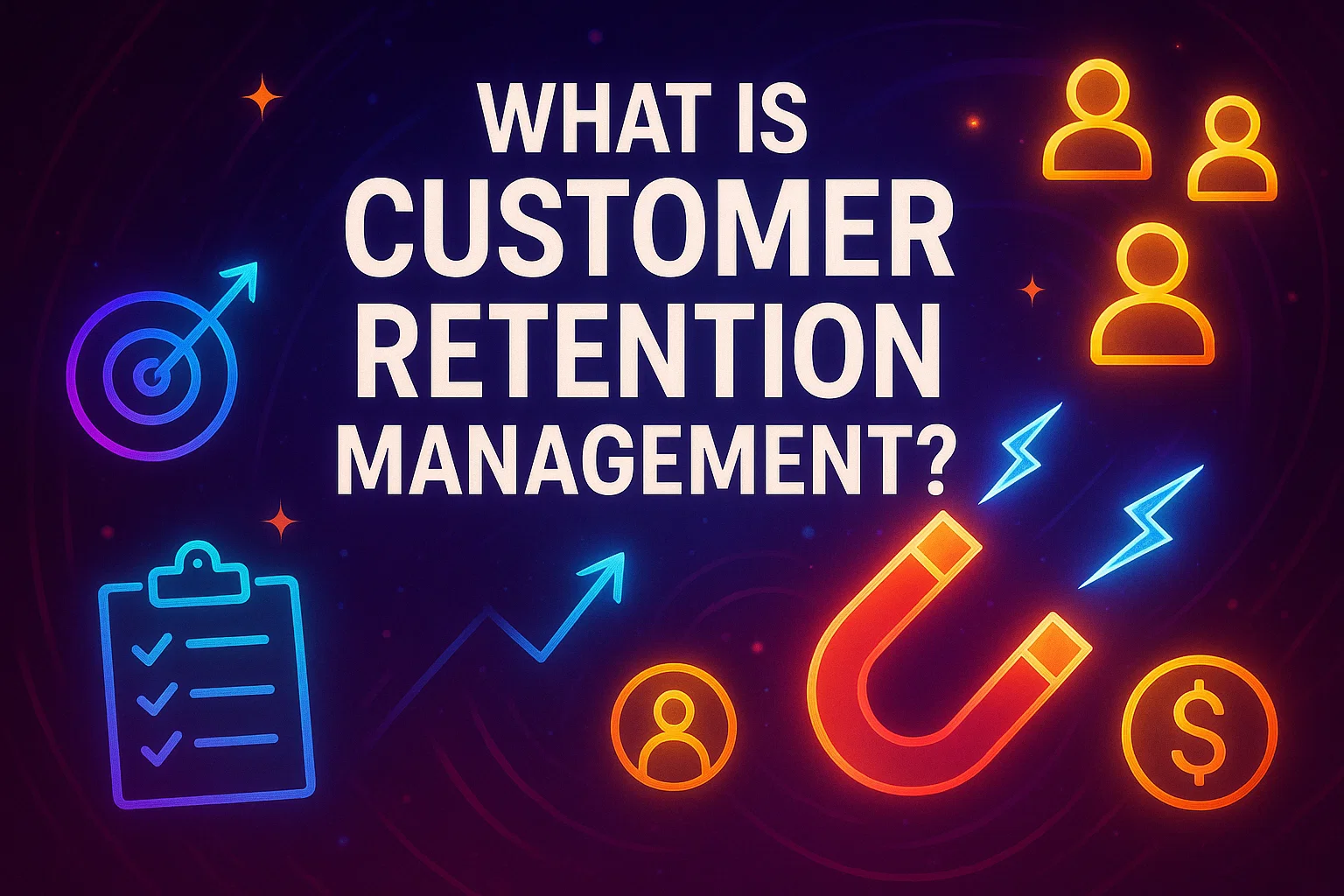
What is Customer Retention Management?
Customer retention management is the strategic business method to keep customers engaged and loyal for the long term.
It is all about building an effective system that helps to build a long-term relationship between the business and the customer after the first sale. The goal is not about preventing churn but improving the lifetime value of each customer. You can make them feel supported and valued.
To reach that goal, you need to optimize the complete workflow, starting from onboarding and personalized communication to loyalty programs. Also, focus on collecting feedback and offering proactive support. When everything is done right, it leads to steady growth and costs less than getting new customers.
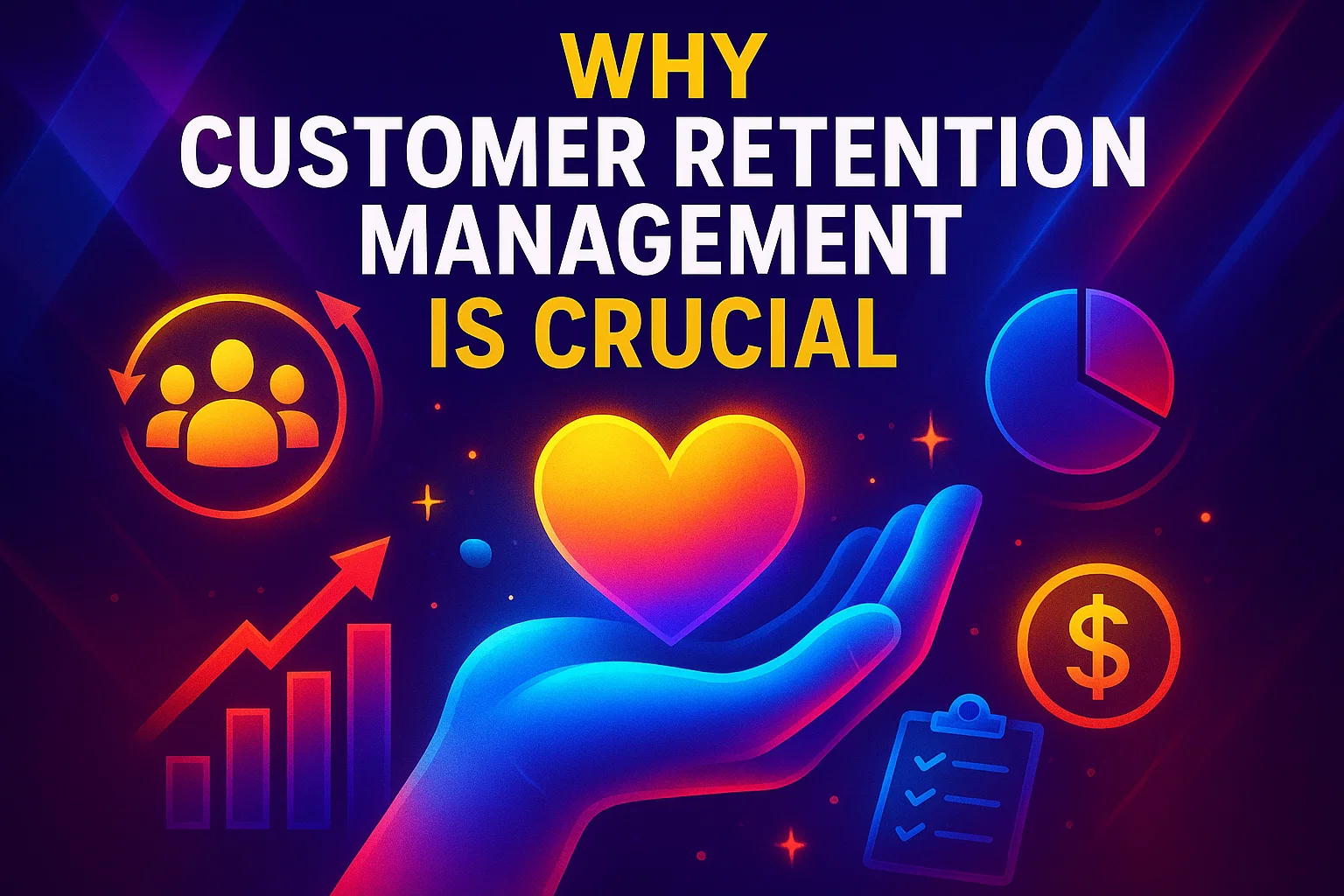
Why Customer Retention Management is Crucial
Retaining the existing customer is not only good for business; to be clear, it is one of the smartest and cost-efficient strategies for growth.
Studies reveal that acquiring a new customer can cost 5 to 7 times more than retaining one. It doesn’t just save money but also helps in getting more value.
- Increased Spending: As with the trust building over time, the customer base you have retained tends to spend more. It also helps in increasing the average order value and purchase frequency of the company.
- Stronger Word-of-Mouth: Satisfied and long-term customers are your best advocates. You can ensure organic growth through referrals.
- Higher Lifetime Value: Most importantly, retained customers help in increasing the Customer Lifetime Value. You can better predict the revenue growth and adjust your strategies accordingly.
All in one, retention drives business growth by providing valuable insights. With the static customer base, you can better collect customer feedback, feature requests, and usage data. You can use these to improve products.
Core Pillars of Customer Retention Management
Proactive onboarding, continual engagement, personalization, and strong customer support are the root to best manage the retention framework. This helps ensure customers remain engaged and loyal, and you are getting continued revenue growth.
1. Proactive Onboarding
The customer retention journey begins the moment a customer engages with your product or service. That’s the point, you need to build a well-structured onboarding process that sets the first stage for long-term success.
You can guide the customer with help resources, starting from the initial stages of product use to how to get the value from them. All these reduce the confusion and build a foundation for long-term engagement.
Pro tip: You can utilize the automated walkthroughs, welcome emails, and first-success milestones to help customers learning more quickly and ensure product win.
2. Continuous Engagement
Customer retention automatically declines with a decrease in customer engagement level. At this stage, you can input the thoughtful interactions and keep your brand top of mind with your customer base. With the consistent and relevant communication, you are not only providing the ongoing value but also ensuring your customers are kept engaged.
3. Personalization at Scale
Today’s customers expect more than generic messaging that you send to all. To have a lasting relationship, you can ensure that you are delivering personalized experiences at scale. For finance, use the data collected from the customer segmentation, behavioral triggers, and customer touchpoint interaction points, even when automated.
4. Predictive Support
Don’t wait for problems to become complaints. By predicting customer issues before they arise, you will have good flexibility to prevent churn.
For instance, use data from customer behavior, like declines in usage or lack of engagement, to implement timely check-ins or reactivation tasks. Through these, you can define issues earlier and resolve the concerns before they impact the customer’s experience.
5. Loyalty and Rewards
Customer retention goes beyond simply preventing churn. It’s about continuously adding the value that your customers get from your product or service. Use the loyalty programs, referral rewards, and find key milestones to increase both emotional and financial investment in your brand.
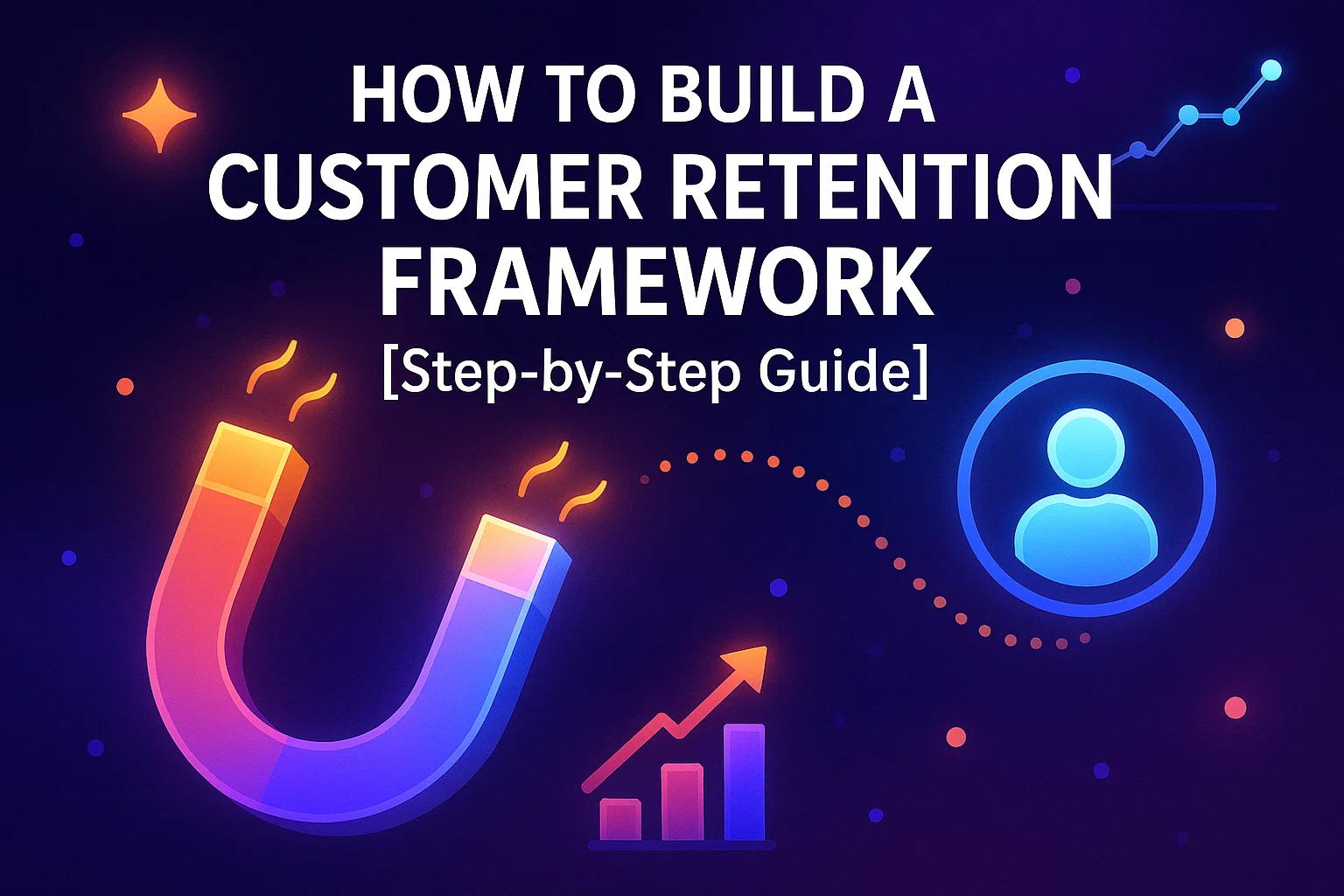
How to Build a Customer Retention Framework [Step-by-Step Guide]
To build an effective customer retention strategy, first, map out the customer journey, define the goals, segment the customer base into groups, and automate your workflow.
Here is the step-by-step guide you can follow:
Step 1: Assess the Full Customer Journey
All you need to do is first identify every stage a customer experiences, starting from onboarding to renewal or expansion. Through this process, you can pinpoint key touchpoints where the customers are struggling and the areas where they are successful. You can also find areas for improvement.
Step 2: Define Success Milestones and Churn Risks
Now, for each stage you have defined in the customer journey, find the success rate and the warning signs that predict potential churn.
For example:
- First product use within 7 days = success milestone
- An unresolved support ticket for 48 hours = red flag
Step 3: Segment Customers Based on Needs and Behavior
Keep note that not every customer requires the same approach. This is the time you need to segment customers based on their lifecycle stage, product usage, subscription type, or engagement level. Through this, you can personalize your outreach and provide customized resources.
Step 4: Design Proactive Engagement Strategies
Now design the retention playbooks with key engagement touchpoints, such as:
- Welcome flows
- Usage tips and best practices
- Re-engagement emails
- Check-ins during periods of low activity
Ensure that every touchpoint is genuinely working rather than feeling like spam.
Step 5: Align Teams Around Retention
Retention is a company-wide initiative. So, ensure that it is not just the responsibility of the Customer Success (CS) team. Include the marketing, support, and product teams, and consistency across all stages of the customer journey, all starting from messaging to service delivery.
Step 6: Automate Where It Adds Value
In this step, utilize the automation for repetitive but valuable tasks, such as:
- Onboarding flows
- Customer education content
- Collecting customer feedback via surveys
While doing so, always ensure there’s room for a personal touch in key interactions.
Step 7: Measure Performance to Improve
The key to a successful retention strategy is ongoing improvement. For instance, you must regularly monitor the performance with key retention metrics, collect customer feedback, and adjust your retention strategies.
Even if it is a strong retention framework, it changes over time. And you need to be on the same pace with changes in your product, customer needs, and business strategy.
How to Implement Customer Retention Strategy
Once your customer retention framework is all set, the next step is execution. All you need to do is implement the proven strategies designed to enhance loyalty, engagement, and retention.
Here are retention tactics that ensure measurable results:
1. Behavioral Email Campaigns
You can utilize personalized email campaigns based on customer behavior:
- Welcome Series: Engage the new customers from the beginning stage with an onboarding sequence.
- Re-engagement Campaigns: Find the customers with low activity and send customized messages to re-engage them.
- Upgrade Suggestions: When your users are showing high usage value, now is the time to suggest relevant product upgrades or premium options to enhance their experience. All these well-timed and personalized communications ensure you feel valued and connected with the company for a longer time.
2. VIP Treatment for Power Users
You can identify the most engaged customers and plan to reward them to enhance the engagement level in the future. To do so:
- Early Access to New Features: Give your top users a quick roundup of upcoming features or products.
- Priority Support: Offer them direct access to dedicated support for a more personalized experience.
- Invitations to Beta Programs or Exclusive Communities: You can engage them in testing new features or invite them to exclusive user communities.
3. Win-Back Sequences for At-Risk Customers
Potentially identify potential churn and re-engage inactive customers. For this, utilize behavior-based triggers such as inactivity for 14+ days and target the win-back campaigns, which may include:
- Exclusive offers
- Valuable content
- Personalized outreach
4. Education Through Content
Educated individuals are likely to be retained. You can offer continuous learning opportunities and help your customers maximize the value of your product or service:
- You can provide step-by-step guides that can enhance user understanding and proficiency.
- Create engaging video content where you can visually showcase key features and use cases.
- Organize live sessions or maintain centralized resources where customers can explore advanced functionalities.
5. Loyalty & Referral Programs
You can encourage customers to keep coming back and share your brand with others by offering rewards. Like:
- Reward your customers as they achieve success, and continue to use them. Here, you can offer them points they can redeem for perks.
- Provide discounts for customers who refer friends or colleagues, turning them into advocates.
- You can offer special benefits for loyal customers and motivate them to engage more often.
6. Feedback-to-Action Loops
Utilize customer feedback as the major part of your strategy to build trust and loyalty. For example, you can use surveys or simple feedback tools to understand what your customers expect from you.
Use the important KPIs such as NPS, CSAT, and get real-time insights. The next step is to share updates. That means let customers know how their feedback helped shape changes. It helps to build trust and results in long-term loyalty.
Essential Tools to Scale Customer Retention
To scale retention, use a combination of CRM systems, email marketing platforms, customer feedback tools, analytics software, and optimize your customer interactions.
1. CRM Platforms (Customer Relationship Management)
Purpose: CRM platforms centralize customer data and help teams to track interactions, manage customer lifecycle stages. You cna get the detailed insights on the behaviors. Play you cna ensure consistent communication and personalized experiences across all touchpoints.
Examples: HubSpot, Salesforce, Zoho CRM
A robust CRM serves as the foundation for customer engagement. Here you will get the unified view of customer history and context. It ensures all the team members, like sales, marketing, and support, are on the same workflow.
2. Customer Success Platforms
Purpose: Monitor customer health scores, automate success workflows, and trigger proactive support actions to enhance the customer experience.
Examples: Gainsight, Totango, ChurnZero
Customer success platforms are designed for retention. You can identify the potential risks early and guide teams to take proactive measures. It helps to build a positive experience for customers across their lifecycle.
3. Email & Journey Automation Tools
Purpose: Automate onboarding, re-engagement, and event-based messaging to personalize customer journeys.
Examples: ActiveCampaign, Customer.io, Klaviyo
Automated and personalized communication helps your customer base stay engaged and active without proactive support from the team. It ensures timely and effective interactions at every stage of the customer lifecycle.
4. Feedback & Sentiment Tools
Purpose: Collect customer feedback through NPS surveys, CSAT scores, and open-text responses to measure satisfaction and sentiment.
Examples: Delighted, Hotjar, Qualtrics
It is essential to better understand the customer sentiment to make informed decisions. It helps to get valuable insights and take the right actions to address issues or improve experiences.
5. Product Analytics Platforms
Purpose: Track user behavior, identify drop-off points, and measure feature adoption to optimize the product experience.
Examples: Mixpanel, Amplitude, Heap
Retention is closely related to how customers experience the product. You can identify what’s working, what’s not, and where targeted improvements are needed to enhance customer satisfaction and reduce churn.
Key Metrics That Improve Retention Decisions
Some of the important retention metrics include customer lifetime value, churn rate, net promoter score, customer satisfaction, and so on.
Here is more you need to know:
1. Customer Retention Rate or CRR
It measures the percentage of customers who continue to use the product or service for the long term.
Why it matters: This is the metric through which you can understand how well you’re keeping customers. It tells you if people will stay or quietly move on.
Formula:
CRR = ((Customers at End of Period – New Customers Acquired During Period) / Customers at Start of Period) * 100
2. Churn Rate
This metric measures the percentage of customers who cancel or stop using your service within a specific time period.
Why it matters: It is just the opposite of retention. A high churn rate means there is a potential issue running through the customer journey, and you need to take immediate action. But you start, make sure to segment churn by some essential factors. This is like the industry-based, or customer lifecycle stage, and identifies areas for improvement.
Formula:
Churn Rate = (Customers Lost During Period / Customers at Start of Period) * 100
3. Customer Lifetime Value or CLV
It measures the total revenue you expect to earn from a customer over the entire duration of their relationship with your business.
Why it matters: Retention improves CLV. The longer a customer stays, the more revenue they generate.
Formula:
CLV = Average Purchase Value × Purchase Frequency × Customer Lifespan
4. Net Promoter Score or NPS
This important metric measures how likely customers are to recommend your business to others.
Why it matters: NPS indicates customer satisfaction and loyalty. With the low scores, you can easily identify the potential churn. You can use it for identifying brand advocates, finding key areas for improvement, and exploring the feedback that gives valuable insight.
Formula:
NPS = % of Promoters – % of Detractors
5. Product Usage & Engagement Metrics
This metric helps to find how and how often customers interact with your product.
Examples:
- Login Frequency
- Feature Adoption
- Session Length
Why it matters: With the low engagement level, you can identify the risk of churn, while high engagement is a strong indicator of retention.
Common Retention Mistakes to Avoid
Even with good intentions, many companies still make mistakes relating to focusing only on acquisition, ignoring customer feedback, offering inconsistent customer support, and so on.
Get the idea with the solution to resolve the issue:
1. Over-Focusing on Acquisition
Though acquiring new customers is important, if you are losing them faster than you’re gaining them, you’re not really growing.
Fix: Make sure you are smartly prioritizing to keep your current customer base as static as much as possible. It is even a cost-effective solution compared to acquiring new ones.
2. One-Size-Fits-All Communication
When you send the same generic message to all your customers, you don’t get the insights on unique behaviors, needs, or levels of engagement.
Fix: The solution is to segment your customers into different groups based on factors like their behavior, lifecycle stage, and engagement level.
3. Waiting Until Churn Happens
It has never been a good practice to only reach out after a customer cancels. By then, it’s already too late to turn things around.
Fix: The best is that if you can keep an eye on things like health scores, inactivity, and other signs that someone might be missing. After finding the early warning signs, reach out before they leave.
4. Ignoring Onboarding Quality
A lot of churn happens early on. If your onboarding experience is confusing or too passive, it’s easy for customers to lose interest quickly.
Fix: Make sure your onboarding helps users see value right away. Offer a structured onboarding process to help customers get the best outcomes.
5. Treating Feedback as a Checkbox
Just collecting NPS feedback and never acting on it can significantly affect the trust. When the customer starts noticing that their feedback goes unanswered, it has a negative impact.
Fix: Always close the loop. Always let the customer know how their feedback led to real updates, improvements, or changes.
Conclusion
Customer retention is not about something you do once. It is something that you need to do continually. It starts with guiding customers to learn about your product, offering great support, and preventing the chances of churn.
When you build a smart plan to keep customers, properly use the right tools, and track what matters, it helps your business grow accordingly.
Author
Shirikant is a proven customer success leader who combines sharp business insight with practical experience to improve retention and drive revenue. As the founder of Statwide, he designs customer-first business strategies that guide companies to turn users into loyal and long-term partners. His approaches are built on real results: stronger relationships, higher customer value, and lasting growth.

